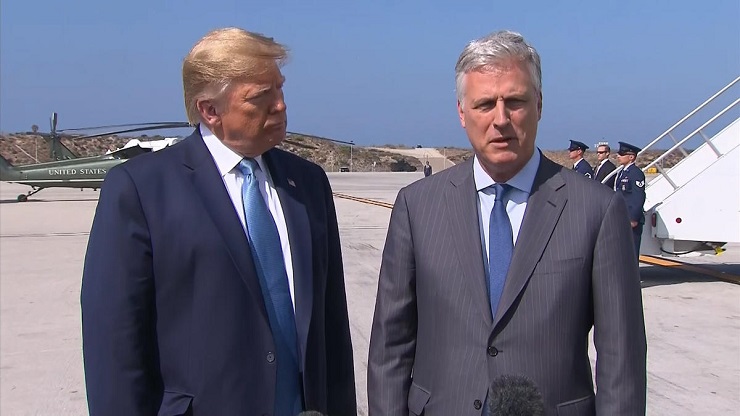While the US continues to target China for its assertive policies in the South China Sea, the US still continues to lose itself out in the ASEAN region. This is a result not so much of the way the Chinese are expanding their political and economic reach, but mainly an outcome of the US’ own handling of the region and its failure to meet the ASEAN countries’ expectations. In the latest ASEAN summit, the US president’s conspicuous absence not only reminded the ASEAN members of the way the US, under the Trump administration, is not only distancing itself from them, but also making no serious efforts to do what the ASEAN countries once hoped the US to do vis-à-vis China: practical containment. The widespread dissatisfaction, evidently expressed through the ASEAN members’ boycott of a US Summit staged at the event overseen by Trump’s national security advisor Robert O’Brien. Brien was certainly seen as a diplomatic representation too junior to preside over a meeting attended by heads of state.
Thus, despite Brien’s diplomatic onslaught on China regarding the latter’s so-called ‘aggressive policies’ in the South China Sea region, no intra-grouping discussion regarding this issue took place. In fact, the ASEAN countries’ refusal to send their respective national leaders to the annual ASEAN-US summit showed that these countries weren’t after all deeply eager to stay attached to the US policies. The US, on the contrary, took the absence of the national leaders as a ‘conspiracy’ and a deliberately designed ‘international effort to embarrass’ the president of the US (who wasn’t after all present in the summit in the first place and perhaps found solace in sending someone not even formally a member of his cabinet).
For the ASEAN countries, Trump’s neglect of the summit was nothing but a clear manifestation of his “America First” policy whereby he prefers to deal with countries on bi-lateral rather than multi-lateral terms and avoids settings that promote regional connectivity. This has already done enough damage to the US ability to unite the ASEAN countries as a “bloc” against China, forcing even some of them, if not all, to refuse to follow a policy that involves taking sides.
The Philippines’ example is a true reflection of the changing dynamics of the US-ASEAN and China-ASEAN growing ties. The Philippine President Rodrigo Duterte, who serves as the current ASEAN-China country coordinator, simply called for mutual “self-restraint” in the South China Sea and did not endorse the US call for action against increasing Chinese ‘aggression’ in the region. While it may be said that The Philippines leader is largely a pro-China man, his position has already made the ASEAN an internally divided house. This is despite the fact that The Philippines is one country with one of the highest stakes in the South China Sea region.
Furthermore, The Philippines is not the only country from within the ASEAN to lean towards China and even evolve its ties into a strategic-partnership. Ever since January 2019, reports have been appearing in the international media about China’s acquisition of a naval base in Cambodia. While there is no official confirmation about this base, the fact remains that China is already the largest investor in Cambodia and has pumped billions into the economy. What also adds to Cambodia’s logic of growing relations with the Chinese is a strong perception in Cambodia regarding a running US-sponsored effort to overthrow Hun Sen, the strongman leader who has been in power for more than three decades now. Phnom Penh also cancelled annual joint military exercises with the US ahead of an anti-democratic crackdown that targeted American interests in the country.
A growing US neglect of the ASEAN as a bloc has already created enough space for the Chinese to expand their political and economic reach. On the one hand, Trump’s preference for bi-lateral ties has distanced some countries, and on the other, it has allowed China to negotiate a separate code of conduct with the ASEAN countries regarding the South China Sea region. While the US hopes to impose its influence on Code of Conduct negotiations by ratcheting up its presence in the South China Sea, such as increasing the number of warships sailing in the sea, Trump’s neglect of the summit and the ASEAN countries’ own assertiveness plus a growing realisation against picking sides is likely to make things more difficult for the US.
For China, these things are working. China has been the largest trading partner of ASEAN for 10 consecutive years. In 2018, bilateral trade between China and ASEAN hit US$580 billion and mutual investment reached over US$200 billion. As against this, the US trade with ASEAN was US$271 billion in total (two way) goods trade during 2018. Trade in services with ASEAN countries (exports and imports) totaled US$62 billion in 2018. Exports were US$37 billion; Services imports were $25 billion.
A decline in mutual economic activity coupled with a growing disinterest in the region shows that the geo-political importance has already watered-down significantly for the US due to a ‘benign neglect’ that can hardly be attributed to any ‘conspiracy’ against the US. China, obviously, stands to gain.
Salman Rafi Sheikh, research-analyst of International Relations and Pakistan’s foreign and domestic affairs, exclusively for the online magazine “New Eastern Outlook”.

